Final report for FW16-028
Project Information
I am just 6 months into this project, progress is moving faster now on my goals and objectives. Most of the work to date has been an overview of designs for solar dryers, ordering materials, designing spec sheets for drying of agricultural products, and finalizing the optimal design. Construction of the dryer is now in progress as the off-season allows me more time to work on construction projects that are not in the field. I expect the dryer to be ready for our first harvest of plants in March 2017.
A year and a half into the project, two dryers were built and run through one season of herb drying. Records have been kept of drying times of plants in season versus timing outside without solar drying. Results are positive and quality of herb drying is excellent. We have a a variety of herbs and plant parts from leaves, to roots and all seems to operate at excellent final product demands.
We have been pleased after the first full year of drying in our solar designs and look forward to the second full year of production. The results have been excellent and have exceeded our expectations. Quality of the finished dried herb is very good and the drying time has extended our season and resulted in above average quality.
Most of our drying recording has been done with manual thermometers to date and have given us good base data. After having to move our base of operation to a new location in 2017 during the drying season we are setting up new stages and hope to upgrade our monitoring with digital recorders and data recovery for detailed reporting. We foresee that happening by the end of June 2018.
Our objectives have been met to date with excellent drying time, good outcomes in quality and usable results from construction and modification of the solar design over the past year.
We will feel much more comfortable with discussing results after 2 years of monitoring and project modifications, then we can expand our educational impact to a larger audience.
Cooperators
Research
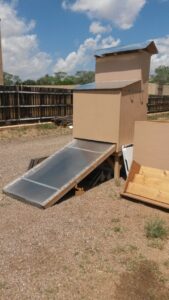
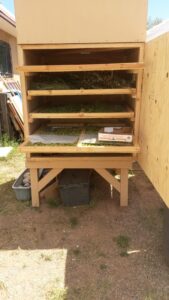

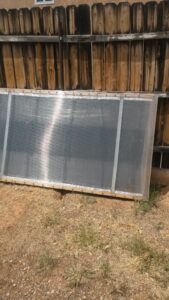
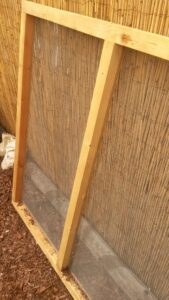
New information is developing for protocols for herb drying based on climatic conditions, dryer efficiency, temperature and time of drying. Quality of the finished product is the governing goal and guide to increased value added of the product. Modification of the original design of the dryer and research methodology will be necessary and reflected in the final report and project progress.
We are in to our second year since inception and the dryers will be tested again to give us 2 years of research and documentation. We have been pleased with the first years' data. See attached Dryer Log of progress for more information.
We have documented temperatures from top to bottom on the drying racks; we found only small differences meaning that the air flow is excellent and there are no "hot spots" with air stagnation. The plants we work with require moderate temperatures and slow to medium drying times. From the bottom drying rack at 82 degrees F to the top one of 94 F during the hottest months of July and August we found the finished product to be excellent in quality.
Solar-Drying-Log-for-Fall-2017-18
Impacts
The project is still in the beginning phase and it is too early to assess any substantial impact other than I have informed my current audience of customers, students, and staff of the project goals and will keep them informed of our progress through our e-newsletter and social media posts.
I did purchase a GoPro camera this year and am using that as a vehicle for video education, the solar dryer will be documented and posted with visual media for others to follow.
Accomplishments
My accomplishment to date are in regard to surveying and researching optimal solar dryer designs and incorporating the best features into my design. Then putting together drawings and ordering materials that are specific to our climate. I have purchased the temperature monitoring equipment and am now ready to get the design built in 2 months. I consider my work in line with my original goals and timelines as the project needs to be completed in the off-season.
The dryers have proven to be effective as a production management tool, adding security in final quality. The herbs were were well protected from the elements and dried at the optimal rate and moisture content. Interest has been high based on regular inquiries at the store and our in-house workshops.
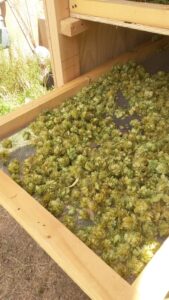
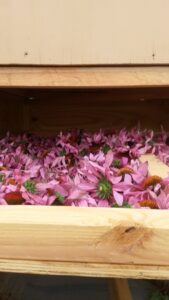
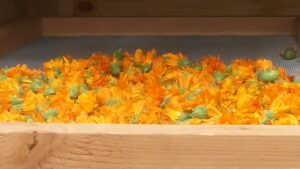
Fresh Calendula Flowers
Research Outcomes
Education and Outreach
Participation Summary:
There has been an ongoing educational program about this project at our store in Santa Fe, New Mexico. Because we are open 6 days a week we have access to a large number of people from the general public to professionals. The dryers have been parked in an open public area near the store entrance and we have numerous people who have asked questions about them. We also hosted weekly educational talks at our store on Fridays and several workshops/talks focused on farm-based technologies to enhance medicinal herb production and use.
We also posted information about the project in our monthly enewsletter as well as on our Facebook posts.
Education and Outreach Outcomes
I believe we have had major successes with this project including development of a unique design for passive solar drying that has not been done before on the commercial scale that we have until now. Previous designs are for home scale and not for larger production scale. Our design can be upgraded to larger boxes and dryers or done in multiple box capacity for larger scale growers. I just recently dried comfrey leaf in 2 days, which is impressive for a leaf with so much water content.
I think some adjustments could be made to improve the drying monitoring system so that simple documentation is emphasized. I am currently talking to a student/colleague who can develop an app for inputting and calculating drying times and grades according to climate and local conditions. Also, more work could be done on interfacing the drying with ongoing herb processing into finished products. Very little research has been done or documented for herb/plant moisture content after drying for the optimal results in products. General information exists however more details are needed to emphasize the optimal dryness for maintenance of medicinal constituents in the targeted herbs. That could be done in comparable studies to time versus quality and comparing that to commercially available herbs from a variety of sources outside the growing area. This type of research would support local growing and quality control for optimal herb benefits in product development, giving the small herb grower an edge over international growers. Many of our commercial grade herbs are imported from Eastern Europe and Asia and very little quality control is applied to those products.
Some herbs that are common such as Red Clover are widely used in herb commerce but grown outside the U.S. and are very unreliable in quality. With greater emphasis on quality control issues in herb production we could support a larger herb growing industry in the U.S., now over 12 billion dollars in revenue per year.
Application of simple technology to enhance efficiency. An attitude change in awareness with the idea of possible new business ventures and increased on-farm value added products. Education of potential value added farm products of herbal teas and accessory products.
Many farmers and growers are looking to simple renewable technologies in particular that they can build themselves. This project interests them for these reasons. We are especially interested to look at this season's results (year 2 ) so we have reliable data for publishing and educational presentations.